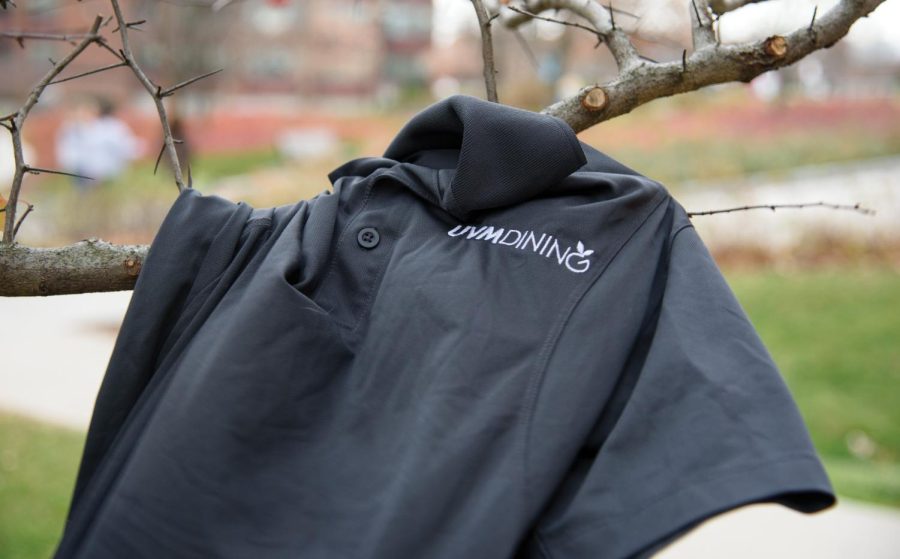UVM Dining workers get neutrality agreement as unionization efforts begin
Photo Illustration: Dining workers are now allowed to unionize without interference from Sodexo, the corporation that handles UVM’s food services.
UVM’s dining concessionaire, Sodexo, signed a neutrality agreement Nov. 8 allowing dining workers the ability to unionize without interference from the company, said Beth Pease, organizing director with the New England Joint Board.
The agreement between negotiators from hospitality labor union UNITE HERE and Sodexo ensures Sodexo will not stop attempts by the UVM dining workers to unionize, said an anonymous part-time student worker representing UVM Students For Dining Workers.
“This is an unexpectedly early victory for us,” the anonymous spokesperson said. “We were preparing to kind of wage this campaign for we-don’t-know-how-long to get this neutrality agreement.”
This opens up a clear pathway for dining workers to potentially unionize into the NEJB, Pease said.
The NEJB, a UNITE HERE regional affiliate, represents workers in a variety of manufacturing and hospitality industries in New England and New York, according to the group’s website.
Workers are currently having conversations with each other and union staff to determine whether or not they want to unionize, Pease said.
Sodexo representatives told UNITE HERE that student and worker organizing efforts motivated them to make the agreement, the anonymous spokesperson said.
“Sodexo respects the rights of our employees to unionize or not to unionize, proven by the hundreds of CBA’s [collective bargaining agreements] we have in good standing with unions across the country,” stated Melissa Zelazny, UVM Dining resident district manager, in a Nov. 10 email.
The agreement allows the dining workers to unionize via a card-check process, the anonymous spokesperson said. This means that workers will circulate and sign union cards, which will be sent to either the Vermont or National Labor Relations Board to be counted.
If a majority signs these cards by early 2025 to early 2026, the workers can form a union, which Sodexo will recognize under the terms of the agreement, the anonymous spokesperson said. Only then can contract negotiations can begin.
“We are confident if employees choose to unionize that we will work in good faith to reach an amicable agreement for workers, the union and UVM administration,” Zelazny stated.
The card-check process is much easier than the alternative method of union formation through the National Labor Relations Board, the anonymous spokesperson said. That alternative process requires a representation election to be held, where workers decide whether to unionize or not.
These elections generally prove less effective at gaining a majority of workers, and they can be influenced by corporations like Sodexo, the anonymous spokesperson said. Corporations use tactics such as bringing in out-of-town professionals to wage anti-union campaigns and break workers’ belief in their collective power, according to the University of California, Berkeley Labor Center.
“Essentially [Sodexo] are saying, ‘we see the momentum this campaign has and we want to do this the easy way,’ as opposed to a protracted battle before the Vermont or National Labor Relations Board in which the company will burn cash, lose and be forced to recognize a union anyway,” the anonymous spokesperson said.
Now, the focus is on campaigning to get a majority of dining workers to unionize who can then collectively bargain for a fair contract, the anonymous spokesperson said.
The total number of dining workers is between 200 and 300, the anonymous spokesperson stated.
Dining workers could elect UNITE HERE and the NEJB to represent them in negotiations, the anonymous spokesperson said.
“For workers in our dining halls to unionize, it takes conversations and it takes building courage and it takes building a sense of collective to figure out what they can fight for and what they could potentially win,” they said.
The UVM Students For Dining Workers’ main purpose now is to support the unionizing process and get the word out about the campaign, the anonymous spokesperson said.
“Sodexo has agreed not to union-bust and not to use bad tactics, but that does not always stop employers,” they said. “So we need to be vigilant and in solidarity with [the workers].”
The unionizing process comes in the context of poor working conditions in the dining halls, the anonymous spokesperson said. Workers face low pay—which is insufficient to live on—unsafe work tasks and long hours.
Many employees work up to 14-hour shifts and over 60-hour work weeks, the anonymous spokesperson said. Workers must fight management to meet basic safety standards, and management silences their complaints.
Low pay and a lack of benefits, such as health care, means workers cannot afford treatment for serious and chronic health issues, the anonymous spokesperson said.
Power imbalance between management and workers has been a major problem as well, the anonymous spokesperson said.
People who may appear less desirable to other employers—such as those who are pregnant, elderly, disabled or recent immigrants—often get forced into long schedules doing very difficult work because Sodexo makes itself out to be the only job that will hire these workers, the anonymous spokesperson said.
Zelazny cannot comment on these issues at this time, she stated in a Nov. 15 email from her and UVM Spokesperson Enrique Corredera.
“Once [the dining workers] win recognition, they would then be able to negotiate over the terms and conditions of work, which is everything,” Pease said.
The union campaign is using the fact that workers currently have the upper hand nationwide as leverage, the anonymous spokesperson said. The campaign is also attempting to take advantage of Sodexo currently facing expiring contracts and renegotiations.
While it is uncertain what a future contract between the workers and Sodexo would include, potential items include pay benefits, disability benefits and maternity and paternity leave, the anonymous spokesperson said. The workers currently have no contract, and thus Sodexo is not required to provide any of these benefits.
“We really have our eyes on the prize of an official, solidified majority voice for the workers,” they said. “Because that would just totally transform the relationship that exists with workers in our dining hall, totally flip the script.”
The next steps for the workers include organizing and building the infrastructure of a union, which involves democratic leadership and having people in various positions take responsibility for making decisions and for operating different parts of the union, the anonymous spokesperson said.
“We have a lot of anticipation, maybe nervous anticipation about what this is going to look like and how this is going to play out,” the anonymous spokesperson said. “But overall, the people are feeling energized. We keep talking about [how] we can’t really believe that this is moving in the way that it is. And yeah, we’re really stoked.”










